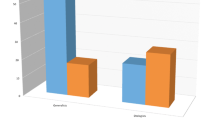Abstract
The aims of this study are to determine the frequency of patients presenting with Meniere’s Disease(MD) in an Indian setting, using the American Academy of Otolaryngology-Head and Neck Surgery (AAO) diagnostic criteria, and to describe the clinical and audio vestibular profiles of these patients. The study was based on prospective case series design in the settings of a tertiary referral hospital. The study included all consecutive patients aged between 5 and 75 years presenting with the history of hearing loss, vertigo, tinnitus and or aural fullness as participants, satisfying inclusion and exclusion criteria for MD (AAO 1995) recruited over a 12 month period. Main outcome measures comprised the evaluation of epidemiological profile, clinical features, and results of audio vestibular investigations like Pure Tone Audiometry with and without glycerol, Impedance Audiometry, Electrocochleography (ECohG), Distortion Product Otoacoustic Emission and Electronystagmography (ENG). The results of the study are as follows: The frequency of MD was 15.6%, being commoner in males than females (2.6:1) and occurring more in the age group 40–49 years among males and 30–39 years among females. High frequency tinnitus was commoner than low frequency tinnitus. Extra tympanic ECohG had a positive predictive value of 76% for endolymphatic hydrops. ENG was useful for demonstrating canal paresis pattern of nystagmus in 61%. Indian patients with MD commonly present to tertiary care at the functional level scale of 3. The results of this study revealed that the frequency of MD is not as low in the Indian ENT setting as earlier believed. There is a high chance of missing cases in the routine ENT outpatient clinic setting unless a structured proforma incorporating the AAO 1995 diagnostic criteria is used.



Similar content being viewed by others
References
Committee on Hearing and Equilibrium (1995) Committee on Hearing and Equilibrium guidelines for the diagnosis and evaluation of therapy in Menieres disease. Otolaryngol Head Neck Surg 113:181–185
Shojaku H, Watanabe Y (1997) The prevalence of definite cases of Meniere’s disease in the Hida and Nhikubiki districts of central Japan. A survey of relatively isolated areas of medical care. Acta Otolaryngol Suppl 528:94–96
Huppert D, Strupp M, Brandt T (2010) Long-term course of Menière’s disease revisited. Acta Otolaryngol 130(6):644–651
Mizukoshi K, Ino H, Ishikawa K et al (1979) Epidemiological survey of definite cases of Meniere’s disease collected by the seventeen members of the Meniere’s Disease Research Committee of Japan in 1975–1976. Adv Otorhinolaryngol 25:106–111
Klockhoff I, Lindblom U (1966) Endolymphatic hydrops revealed by glycerol test preliminary report. Acta Otolaryngol 61(5):459–462
Watanabe Y, Mizukoshi K, Shojaku H et al (1995) Epidemiological and clinical characteristics of Meniere’s disease in Japan. Acta Otolaryngol Suppl 519:206–210
Harris JP, Alexander TH (2010) Current-day prevalence of Ménière’s syndrome. Audiol Neurootol 15(5):318–322 Epub 2010 Feb 18
Paparella MM, Mancini F, Liston SL (1984) Otosclerosis and Meniere’s syndrome: diagnosis and treatment. Laryngoscope 94:1414–1417
Enander A, Stahle J (1967) Hearing in Meniere’s disease. A study of pure-tone audiograms in 334 patients. Acta Otolaryngol 64(5):543–546
Belinchon A, Perez-Garrigues H, Tenias JM, Lopez A (2011) Hearing assessment in Meniere’s disease. Laryngoscope 121(3):622–626
Paparella MM, Mancini F (1985) Vestibular Meniere’s disease. Otolaryngol Head Neck Surg 93(2):148–151
Herraiz C, Tapia MC, Plaza G (2006) Tinnitus and Meniere’s disease: characteristics and prognosis in a tinnitus clinic sample. Eur Arch Otorhinolaryngol 263(6):504–509
Haid CT, Watermeier D, Wolf SR et al (1995) Clinical survey of Meniere’s disease: 574 cases. Acta Otolaryngol Suppl 520:251–255
Brenner M, Hoistad DL, Hain TC (2004) Prevalence of thyroid dysfunction in patients with Ménière’s disease. Arch Otolaryngol Head Neck Surg 130(2):226–228
Meyerhoff WL, Paparella MM, Gudbrandsson FK (1981) Clinical evaluation of Meniere’s disease. Laryngoscope 91(10):1663–1668
Akioka K, Fujita N, Kitaoku Y et al (1990) A clinical study of the diagnosis of endolymphatic hydrops aspect of Meniere’s disease. In: Kitahara M (ed) Meniere’s disease. Springer Verlag, Toronto, pp 125–132
Cianfrone G, Ralli G, Fabbricatore M et al (2000) Distortion product otoacoustic emissions in Meniere’s disease. Scand Audiol 29(2):111–119
Gibson WP, Moffat DA, Ramsden RT (1977) Clinical electrocochleography in the diagnosis and management of Meniere’s disorder. Audiology 16(5):389–401
Chung WH, Cho DY, Choi JY et al (2004) Clinical usefulness of extratympanic electrocochleography in the diagnosis of Meniere’s disease. Otol Neurotol 25(2):144–149
Conflict of interest
None
Author information
Authors and Affiliations
Corresponding author
Rights and permissions
About this article
Cite this article
Selvakumar, P., Balraj, A., Kurien, R. et al. Clinical and Audio Vestibular Profile of Meniere’s Disease in a Tertiary Care Centre in India. Indian J Otolaryngol Head Neck Surg 64, 351–355 (2012). https://doi.org/10.1007/s12070-011-0352-1
Received:
Accepted:
Published:
Issue Date:
DOI: https://doi.org/10.1007/s12070-011-0352-1




